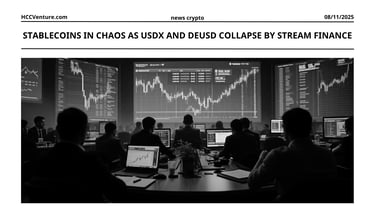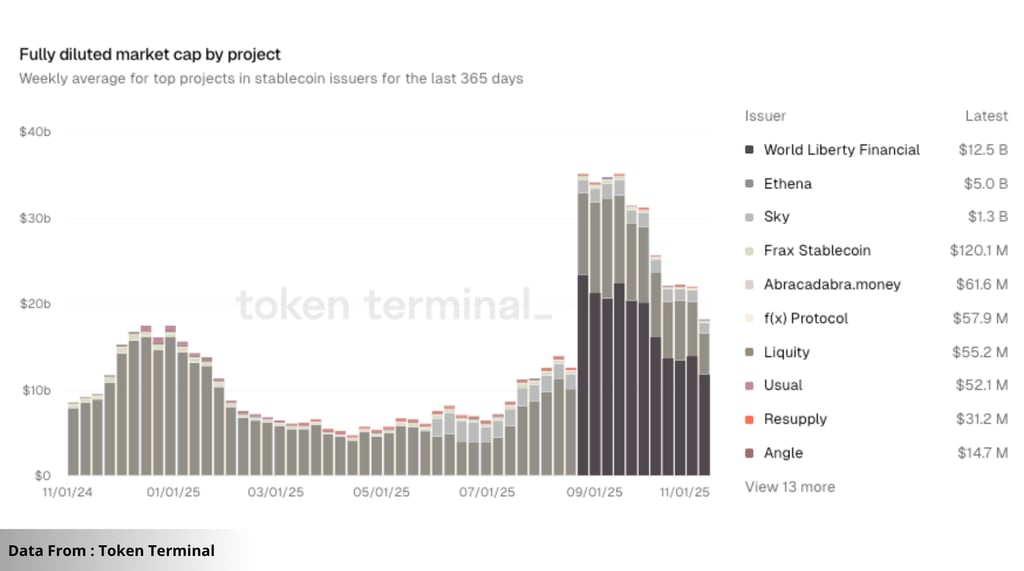Stablecoins in chaos as USDX and deUSD collapse by Stream Finance
The DeFi stablecoin industry has been thrown into turmoil after Stream Finance revealed a $93 million loss from an external fund manager, sparking a series of worrying declines for the asset class.
11/8/20252 min read


What's Happening to Stablecoins?
The stablecoin market — long considered the “safe harbor” of digital finance — is facing one of its most turbulent times in 2025. Following the collapse of Stream Finance and the liquidity disruption on Balancer, several stablecoins have now fallen into crisis.
Among the coins hit hardest were USDX, issued by Stable Labs, which lost its peg to the US dollar, and Elixir Finance's deUSD , whose team officially announced the project's demise after failing to restore its reserves.
This string of failures has reignited market concerns about the structural fragility of algorithmically backed and hybrid stablecoins, with concerns that confidence in decentralized dollar alternatives could once again be eroded.
Chaotic chain reaction
The cause was a $93 million loss by Stream Finance, which resulted in a nearly 60% collapse of its native stablecoin XUSD, due to the company’s external reserve manager mismanaging off-chain investments. The event created liquidity contagion across interconnected DeFi ecosystems — especially those using Stream’s stablecoin or Balancer pools to route liquidity.
As Balancer's liquidity imbalance worsened, stablecoins pegged to the USD but indirectly backed by Stream assets began to collapse. The first domino to fall was USDX, issued by Stable Labs, which lost its peg and plummeted to $0.64 amid massive withdrawals. On-chain data shows that liquidity in USDX Curve pools fell by more than 70% in 48 hours as arbitrageurs withdrew their funds en masse.


Shortly thereafter, Elixir Finance announced the “death” of the deUSD stablecoin, confirming that its collateral framework—partially backed by Stream and XUSD—had become insolvent. The Elixir team stated that “ deUSD can no longer maintain its peg due to upstream collateral losses ” and has halted issuance and withdrawals indefinitely.
Wider market impact
This incident has sparked a second wave of confidence crisis in the decentralized stablecoin sector. According to on-chain analysis, more than $1.2 billion in stablecoin capital has left DeFi protocols in the past 72 hours , as investors turned to centralized alternatives such as USDT (Tether) and USDC (Circle).
Liquidity on major decentralized exchanges (DEXs) — including Curve, Aerodrome, and Maverick — has plummeted, with USD pairs slipping to levels not seen since the TerraUSD (UST) collapse in 2022.
Institutional traders are increasingly turning to fiat-backed stablecoins and tokenized treasury assets, reflecting a broader risk-off trend in the decentralized liquidity market.
Old error but new package?
Despite the technical developments, these incidents show that the core vulnerabilities of algorithmic and hybrid stablecoins remain unchanged:
Collateral management is not transparent, especially when it comes to off-chain assets.
Cyclical dependence on liquidity pools and synthetic pegs, making them vulnerable to mass liquidations.
Inadequate capital recovery infrastructure prevents rapid capital movement when confidence collapses.
While projects like USDX and deUSD position themselves as “next-generation stablecoins,” their hybrid structure—combining algorithmic balancing with external yield farming—ultimately mirrors the fragility that doomed previous experiments like UST, IRON, and MIM.
Disclaimer: The information presented in this article is the author's personal opinion in the cryptocurrency field. It is not intended to be financial or investment advice. Any investment decision should be based on careful consideration of your personal portfolio and risk tolerance. The views expressed in this article do not represent the official position of the platform. We recommend that readers conduct their own research and consult with a professional before making any investment decisions.
Explore HCCVenture group
HCCVenture © 2023. All rights reserved.


Connect with us
Popular content
Contact to us
E-mail : holdcoincventure_contact@hccventure.com
Register : https://linktr.ee/holdcoincventure
Disclaimer: The information on this website is for informational purposes only and should not be considered investment advice. We are not responsible for any risks or losses arising from investment decisions based on the content here.


TERMS AND CONDITIONS • CUSTOMER PROTECTION POLICY
ANALYTICAL AND NEWS CONTENT IS COMPILED AND PROVIDED BY EXPERTS IN THE FIELD OF DIGITAL FINANCE AND BLOCKCHAIN BELONGING TO HCCVENTURE ORGANIZATION, INCLUDING OWNERSHIP OF THE CONTENT.
RESPONSIBLE FOR MANAGING ALL CONTENT AND ANALYSIS: HCCVENTURE FOUNDER - TRUONG MINH HUY
Read warnings about scams and phishing emails — REPORT A PROBLEM WITH OUR SITE.
